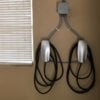As a future owner of a Model X and very likely a Model E, I think it would be helpful to me and others to see pictures of current HPWC installations to help in planning, specifying and documenting to obtain quotes. In my case I'm considering 2 HPWC's with full 100amp. feeds from 2 separate main breaker panels to be able to charge both cars simultaneously if need be. I know it's overkill but so was the 400amp. service and 15.25Kw PV system I put in two years ago and now glad I did.
The only commercial installation I have seen is in the parking garage for the Tesla store in Newport Beach CA where my wife and I test drove a Model S. That installation required a 100amp. disconnect switch near the HPWC I think because it is a commercial location. The same may be true for other business locations and condo and apartment complexes but I am not sure.
Any pictures you could share of residential or commercial installations would be greatly appreciated.
The only commercial installation I have seen is in the parking garage for the Tesla store in Newport Beach CA where my wife and I test drove a Model S. That installation required a 100amp. disconnect switch near the HPWC I think because it is a commercial location. The same may be true for other business locations and condo and apartment complexes but I am not sure.
Any pictures you could share of residential or commercial installations would be greatly appreciated.






